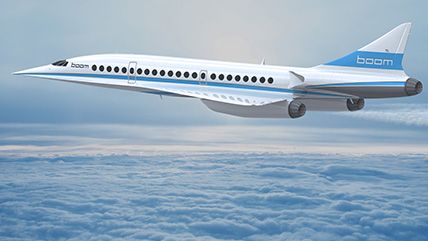Here Comes Supersonic Flight: The Rebirth of a Former White Elephant
Boom Technology wants to take you from New York to London in three hours.

"Really unique in the history of technology is to have a capability and then lose it," says Blake Scholl, founder and CEO of the aviation startup Boom Technology. "We're going to see renewed progress in air travel. My long-term mission at Boom is to make that happen."
When the Concorde made its commercial debut in 1976, it was an engineering marvel that represented the technological promise of the 20th century. But 27 years after its initial flight, the Concorde landed for the final time, ending the era of civilian supersonic travel.
So why did the airliner of the future become a museum artifact?
The Concorde was always a state-funded white elephant so when costs went up and ticket sales dropped, the French and British governments who were backing the venture decided to pull the plug and retire the aircraft.
Another factor that hobbled the evolution of supersonic flight was an overland speed limit imposed in both the U.S. and Europe. The speed ban was pushed by environmental activists—like those in the Anti-Concorde Project and Citizens League Against the Sonic Boom—who claimed that this type of aircraft would generate "the loudest noise" ever heard, or the equivalent to a bomb going off.
"If that was the case there would have been a noise limit, not a speed limit," says Scholl.
Fourteen years after the Concorde was grounded, private companies are on the verge of bringing supersonic air travel back. And this time it'll be built on sound economic principles.
To circumvent the overland travel ban, Boom Technology's aircraft will mainly fly over water. And the company has devised a new form factor for the plane: a three engine jet that can carry up to 55 passengers and flies more than twice the speed of sound.
"My personal favorite feature is a cup holder that is nowhere close to where you put your laptop," says Scholl.
Boom expects to charge $5,000 round trip from New York to London. A ticket for the Concorde set its passengers back about $15,000 in today's dollars.
Scholl's company isn't alone in its quest to speed up air travel. It has several private competitors, and NASA is working with the engineering firm Lockheed Martin to come up with its own version of a supersonic plane. The difference? Boom's demonstrator jet will cost roughly $30 million compared to NASA's plane, which is expected to cost at least $300 million when completed.
"Private industry is able to do this roughly at an order of magnitude cheaper than government and also without requiring any taxpayer money," states Scholl.
Current regulations will prevent companies like Boom from offering supersonic flights between California and New York. Before they can enter that market, the FAA would need to overturn its ban on overland travel.
"Reverse that and now New York to San Francisco could be 2 hours and 20 minutes," says Scholl.
Boom revealed its design for the XB-1 demonstrator jet last November, and is working with Richard Branson's Virgin Galactic to build and test the prototype in 2017. They aim to start flying commercial air passengers in the early 2020s.
"We're fans of speed so we're doing this as quickly as possible," states Scholl. Boom's calculates that if supersonic flight can catch on with business travelers market forces will do their work by improving technology and bringing down costs—making supersonic flight accessible to more people.
"Nobody wants a longer flight," says Scholl. "This is a chance for airlines to make it significantly faster."
Produced by Alexis Garcia. Camera by Austin Bragg. Additional footage courtesy Boom Technology, Department of Defense, and NASA. Music by Vibe Tracks, Jason Farnham, & Audionautix. Cycles by Audionautix is licensed under a Creative Commons Attribution license.


Show Comments (48)